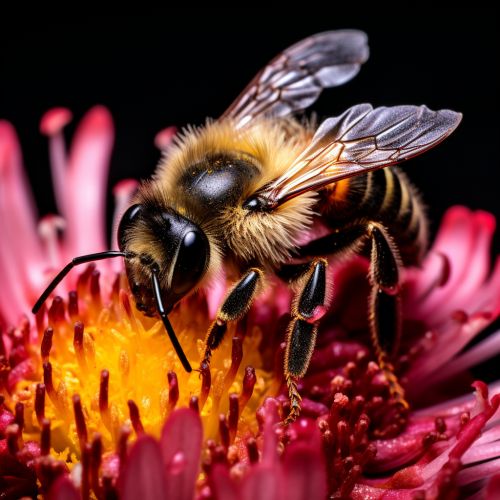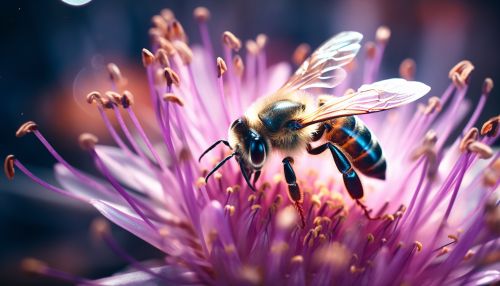The Evolution of Insect Pollinators and Flowering Plants
Introduction
The evolution of insect pollinators and flowering plants (angiosperms) is a fascinating field of study within evolutionary biology. It is a prime example of coevolution, where two or more species reciprocally affect each other's evolution. This article delves into the intricate relationship between these two groups, exploring the evolutionary mechanisms and processes that have shaped their mutualistic relationship over millions of years.


Evolutionary Origins
The origin of insect pollinators and flowering plants dates back to the Mesozoic era, approximately 140 million years ago. The first insect pollinators were likely beetles, as they are among the most ancient groups of insects and their fossil record predates the appearance of flowering plants. The evolution of flowering plants, on the other hand, is a subject of ongoing research, with theories suggesting an origin in the early Cretaceous period.
Insect Pollinators
Insect pollinators include a diverse group of insects such as bees, butterflies, moths, beetles, and flies. These insects have evolved various adaptations to facilitate pollination, including body structures for pollen collection, behaviors for locating and extracting nectar, and physiological mechanisms for digesting nectar.
Bees
Bees are the most efficient pollinators among insects. They have specialized structures such as pollen baskets (corbiculae) on their hind legs, and long, tubular tongues (proboscises) for extracting nectar from flowers. Bees also exhibit behaviors such as flower constancy, where they visit the same species of flowers during a foraging trip, enhancing cross-pollination.
Butterflies and Moths
Butterflies and moths are also important pollinators. They have long proboscises that allow them to reach the nectar of long-tubed flowers. Their bodies are covered with scales that easily pick up pollen. Moths, being nocturnal, pollinate night-blooming flowers that are often white or pale-colored and have strong scents.
Beetles and Flies
Beetles and flies are less specialized for pollination but still play a significant role. Beetles often pollinate flowers that are bowl-shaped, brightly colored, and have a strong odor. Flies, particularly hoverflies, are important pollinators of open flowers that have easily accessible nectar.
Flowering Plants
Flowering plants, or angiosperms, are the most diverse group of land plants. They have evolved a variety of floral traits to attract specific pollinators, including flower shape, color, scent, and timing of blooming. These traits often correspond to the sensory capabilities and preferences of their pollinators, resulting in specialized plant-pollinator relationships.
Flower Shape
The shape of a flower can indicate the type of pollinator it attracts. For example, tubular flowers are often pollinated by bees, butterflies, and hummingbirds, which have long tongues to reach the nectar. Bowl-shaped flowers are typically pollinated by beetles and flies.
Flower Color
Flower color is another important trait in attracting pollinators. Bees are attracted to blue and yellow flowers, while butterflies prefer red and purple flowers. Moths and bats, which are nocturnal, are attracted to white or pale-colored flowers that are visible in low light.
Flower Scent
The scent of a flower can also attract specific pollinators. Bees are attracted to sweet scents, while flies are attracted to foul or rotten odors. Moths are attracted to strong, sweet scents that are released at night.
Timing of Blooming
The timing of blooming can also be synchronized with the activity patterns of pollinators. For example, night-blooming flowers are often pollinated by nocturnal insects like moths and beetles.
Coevolution of Insect Pollinators and Flowering Plants
The coevolution of insect pollinators and flowering plants is a dynamic process involving reciprocal selection pressures. This has led to the evolution of complex plant-pollinator relationships, where changes in one species can drive evolutionary changes in the other.
Pollinator-Mediated Selection
Insect pollinators can exert selection pressure on flowering plants by favoring certain floral traits. This can lead to the evolution of specialized flowers that are adapted to specific pollinators, a process known as pollinator-mediated selection.
Floral Mimicry
Some flowering plants have evolved to mimic the visual or olfactory cues of female insects to attract male insects for pollination, a phenomenon known as floral mimicry. This is a remarkable example of the intricate coevolutionary relationships between insect pollinators and flowering plants.
Conclusion
The coevolution of insect pollinators and flowering plants is a fascinating and complex process that has shaped the biodiversity of our planet. It highlights the intricate interplay between species and the environment, and the dynamic nature of evolutionary processes.
